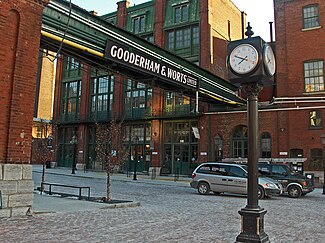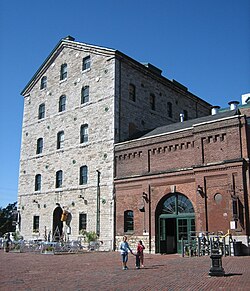Distillery District
| Distillery District | |
|---|---|
| Neighbourhood | |

Distillery District street level
|
|
 |
|
| Country | Canada |
| Province | Ontario |
| City | Toronto |
| Gooderham and Worts Distillery | |
|---|---|

|
|
| Location | Toronto, Ontario, Canada |
| Coordinates | 43°39′02″N 79°21′35″W / 43.65056°N 79.35972°WCoordinates: 43°39′02″N 79°21′35″W / 43.65056°N 79.35972°W |
| Built | Existing historic buildings constructed between 1859 and 1927 |
| Original use | Distillery |
| Current use | Mixed-use neighbourhood |
| Website | http://www.thedistillerydistrict.com/ |
| Designated | 1988 |
The Distillery District is a commercial and residential district in Toronto, Ontario, Canada. Located east of downtown, it contains numerous cafés, restaurants, and shops housed within heritage buildings of the former Gooderham and Worts Distillery. The 13 acres (5.3 ha) district comprises more than forty heritage buildings and ten streets, and is the largest collection of Victorian-era industrial architecture in North America.
The district was designated a National Historic Site of Canada in 1988.
The Gooderham and Worts Distillery was founded in 1832 and by the late 1860s was the largest distillery in the world. Once providing over 2 million US gallons (7,600,000 L) of whisky, mostly for export on the world market, the company was bought out in later years by rival Hiram Walker Co., another large Canadian distiller. Its location on the side of the Canadian National Railway mainline and its proximity to the mouth of the original route of the Don River outlet into Lake Ontario created a hard edge which separated the district from neighbouring communities. These did however, allow for a facilitated transport connection to the rest of Canada and the world and acted as Toronto's domination as an industrial centre or transshipping hub.
With the deindustrialization of the surrounding area in the late 20th century, and the winding-down of the distillery operations, the district was left increasingly derelict. Surrounding industrial and commercial buildings and structures were often demolished, leaving the former distillery surrounded primarily by empty lots. Nonetheless, the closing of the remaining distillery operations in 1990 created redevelopment and investment opportunities for a district that contained the largest and best preserved collection of Victorian-era industrial architecture in North America.
...
Wikipedia
